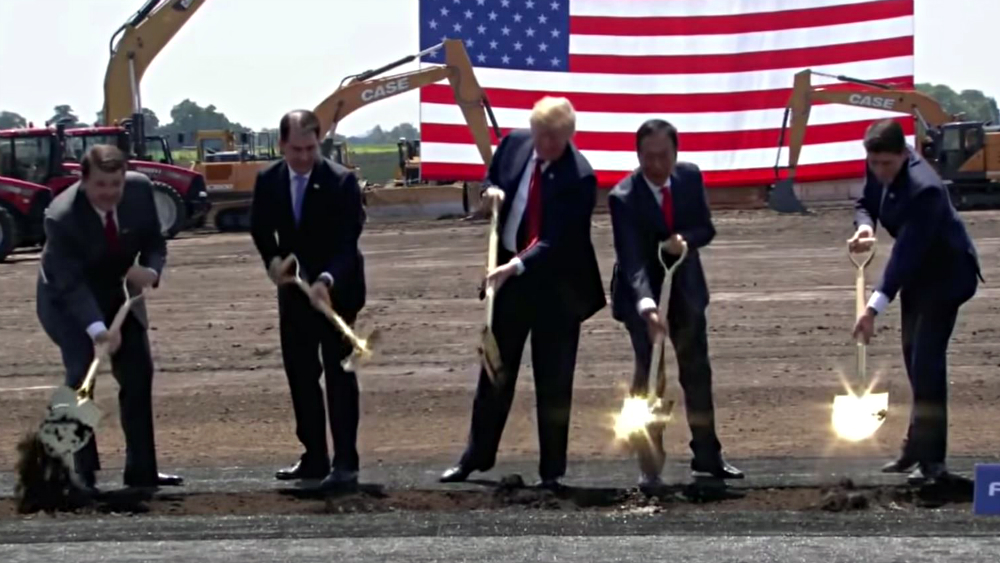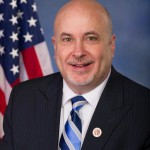Foxconn May Cut State GDP By $6 Billion
Loss could have been as high as $19 billion under original plan, study says.

On June 28, 2018, the first Wisconsin Foxconn employee C.P. “Tank” Murdoch, Wisconsin Governor Scott Walker, President Donald Trump, Foxconn CEO Terry Gou and U.S. House Speaker Paul Ryan conducted the ceremonial groundbreaking at the Foxconn campus in Mount Pleasant. Photo from The White House.
Two recent news stories give even more evidence of what a disastrous deal Republican Gov. Scott Walker made with Foxconn. A new study by the Mercatus Center at George Mason University uses Foxconn as a case study of state subsidies gone wrong, concluding it will have a very negative impact, causing an overall loss of up to $6 billion for Wisconsin’s economy. And Foxconn’s revised plans for its Green Bay satellite center show it is scrapping the idea of an innovation center, yet another step backward for the ever-shrinking project.
The study was not by some liberal opponents of business, but by a research center that bills itself as “the world’s premier university source for market-oriented ideas.” Of course, given that free market orientation, you might expect that researchers Matthew Mitchell, Michael Farren, Jeremy Horpedahl and Olivia Gonzalez would have problems with state subsidies, and they do, arguing that a “targeted approach to economic development is ineffective at best and counterproductive at worst.”
Among the problems with subsides Foxconn exemplified:
–Most subsidized companies would have located there anyway. The study notes a review of 34 academic research papers which shows that only in a minority of cases are company location decisions driven by a subsidy. Foxconn needed a huge source of fresh water for its original plan which made a location on the Great Lakes essential. The Racine location also provided plentiful land and quick access to Chicago, with one of the country’s largest airports and cities. Companies often create a competition for where they will locate, the study notes, while ending up where they always intended to locate.
-Subsidies often pay for yesterday’s technology. “A second, third, or fourth cluster around the same industry in another location is less likely to be successful, not more so,” the study notes. Less than a year after the Foxconn deal was signed, company officials revealed they couldn’t create large scale LCDs competitively in the U.S. and the international market for them was glutted.
-Subsidies can distort the local economy: The huge subsidy for Foxconn could instead “have built 7 square miles of greenhouses to motivate orange growers to move from Florida,” the study notes, which would create jobs but would have been a foolhardy investment. “The targeted subsidy… may encourage the region to overspecialize or to specialize in a way that is not consistent with its comparative advantage” and “may discourage the sort of clustering that would occur naturally.”
–Subsidized companies don’t live up to the deal: Under the original deal the state agreed to $3 billion in subsidy in return for Foxconn’s $10 billion investment and creation of 13,000 jobs. But the final agreement of November 2017 allowed Foxconn to claim the full subsidy with only $9 billion in investments and 10,400 workers, even as the proposed subsidy later grew to $4.1 billion. ”To those who track subsidies, this change was not surprising. In fact, a recent state audit has found that, on average, firms receiving Wisconsin subsidies create only about 34 percent of promised jobs,” the study noted.
-A subsidy doesn’t “pay for itself” or enlarge the tax base: “Research by scholars at North Carolina State University finds that incentives tend to draw resources away from state governments and… negatively affect state fiscal health. Other research suggests that, over time, subsidies crowd out state spending on public goods.”
Subsidies hurt companies that aren’t subsidized. Just one firm gets a multi-billion subsidy “while some 16,000 other Wisconsin businesses must pay a corporate income tax that could be reduced by 22 percent in the absence of that subsidy,” the study notes. Or all Wisconsin taxes could have been reduced by 1.07 percent. The higher taxes caused by the Foxconn deal will create an estimated economic loss of up to $34.3 billion for the original Foxconn Gen 10.5 plant or up to $10.6 billion for the scaled down Gen. 6 plan with a smaller state subsidy.
Comparing the potential economic impact of Foxconn with the loss caused by the taxes needed to subsidize the deal. the researchers come up with a net economic loss of $1.2 to $6 billion for the current down-sized subsidy going to Foxconn. (The spread depends on the percentage likelihood that the company would have located here anyway without a subsidy.) But the loss could have been as high as $19.2 billion had the full subsidy for the bigger plant been awarded. In short, the study notes, it was very fortunate for Wisconsin that the Gen 10.5 plant wasn’t built.
Just a few days after this study was released, Foxconn announced it had selected companies to do the design and construction on its satellite location in Green Bay. Recall that Foxconn announced it would be building satellite centers in Milwaukee and Eau Claire as well, in what looked like an attempt to help Walker’s reelection effort by showing the entire state would benefit from the deal.
In short, the company won’t be using most of the building it bought. As for the idea that this project will be an “innovation center” that will “inspire innovative ideas and catalyze cutting-edge solutions from companies and entrepreneurs” in the area and will hire “200 engineers”, all of which the company promised back in 2018, there was no mention of any of that in the press release.
No, this will be a place to “house Foxconn events and recruitment drives” and “a space for community engagement,” the company declared. As to why that recruitment couldn’t be done more conveniently — and cheaply — at its main facilities in Racine County, there was no explanation.
The whole thing seems to demonstrate another conclusion of the recent Foxconn study, that state handouts result in the subsidized company wasting resources and spending their efforts “thinking of new and different ways to seek privileges rather than new and different ways to create value for customers.”
So Foxconn has bought a little good will in the Green Bay area as it continues to push for the maximum possible subsidy it can get from its new and reluctant partner, Gov. Tony Evers. Meanwhile, the original idea of transforming Wisconsin into a high-tech powerhouse has vanished, along with the now retired huckster CEO of Foxconn, Terry Gou, who sold Walker on the idea.
If you think stories like this are important, become a member of Urban Milwaukee and help support real, independent journalism. Plus you get some cool added benefits.
More about the Foxconn Facility
- Foxconn Acquires 20 More Acres in Mount Pleasant, But For What? - Joe Schulz - Jan 7th, 2025
- Murphy’s Law: What Are Foxconn’s Employees Doing? - Bruce Murphy - Dec 17th, 2024
- With 1,114 Employees, Foxconn Earns $9 Million in Tax Credits - Joe Schulz - Dec 13th, 2024
- Mount Pleasant, Racine in Legal Battle Over Water After Foxconn Failure - Evan Casey - Sep 18th, 2024
- Biden Hails ‘Transformative’ Microsoft Project in Mount Pleasant - Sophie Bolich - May 8th, 2024
- Microsoft’s Wisconsin Data Center Now A $3.3 Billion Project - Jeramey Jannene - May 8th, 2024
- We Energies Will Spend $335 Million on Microsoft Development - Evan Casey - Mar 6th, 2024
- Foxconn Will Get State Subsidy For 2022 - Joe Schulz - Dec 11th, 2023
- Mount Pleasant Approves Microsoft Deal on Foxconn Land - Evan Casey - Nov 28th, 2023
- Mount Pleasant Deal With Microsoft Has No Public Subsidies - Evan Casey - Nov 14th, 2023
Read more about Foxconn Facility here
Murphy's Law
-
National Media Discovers Mayor Johnson
 Jul 16th, 2024 by Bruce Murphy
Jul 16th, 2024 by Bruce Murphy
-
Milwaukee Arts Groups in Big Trouble
 Jul 10th, 2024 by Bruce Murphy
Jul 10th, 2024 by Bruce Murphy
-
The Plague of Rising Health Care Costs
 Jul 8th, 2024 by Bruce Murphy
Jul 8th, 2024 by Bruce Murphy






















This just gets worse and worse, and I’m not a bit surprised. $1-6 billion out of my grandchildren’s pockets, should they choose to stay in Wisconsin. Was this handwriting on the wall from the beginning? Yes!
And where, Walker, is our high-speen train to Madison?